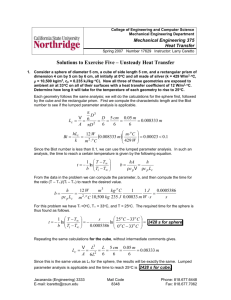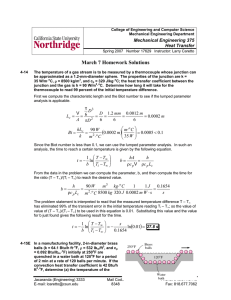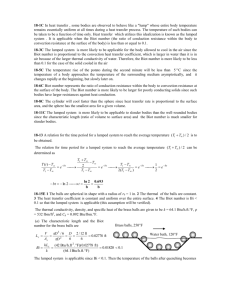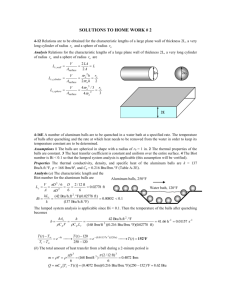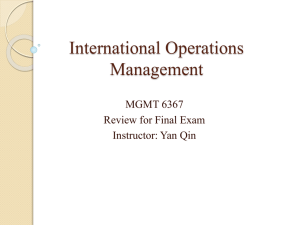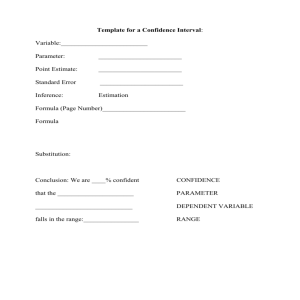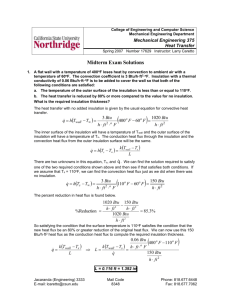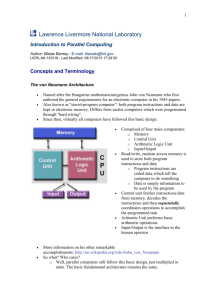College of Engineering and Computer Science Mechanical
advertisement
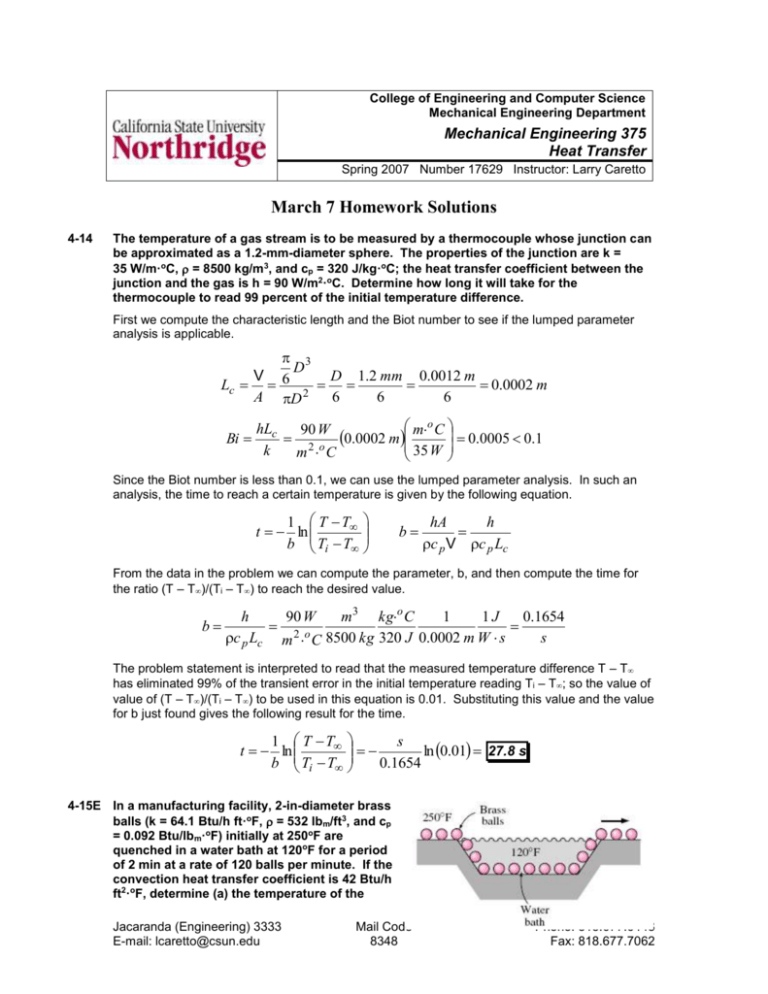
College of Engineering and Computer Science Mechanical Engineering Department Mechanical Engineering 375 Heat Transfer Spring 2007 Number 17629 Instructor: Larry Caretto March 7 Homework Solutions 4-14 The temperature of a gas stream is to be measured by a thermocouple whose junction can be approximated as a 1.2-mm-diameter sphere. The properties of the junction are k = 35 W/m·oC, = 8500 kg/m3, and cp = 320 J/kg·oC; the heat transfer coefficient between the junction and the gas is h = 90 W/m2·oC. Determine how long it will take for the thermocouple to read 99 percent of the initial temperature difference. First we compute the characteristic length and the Biot number to see if the lumped parameter analysis is applicable. 3 D V 6 D 1.2 mm 0.0012 m Lc 0.0002 m A D 2 6 6 6 Bi mo C hLc 90 W 0.0005 0.1 2 o 0.0002 m k 35 W m C Since the Biot number is less than 0.1, we can use the lumped parameter analysis. In such an analysis, the time to reach a certain temperature is given by the following equation. 1 T T t ln b Ti T b hA h c p V c p Lc From the data in the problem we can compute the parameter, b, and then compute the time for the ratio (T – T)/(Ti – T) to reach the desired value. b h c p Lc m3 kgo C 1 1J 0.1654 s m 2 o C 8500 kg 320 J 0.0002 m W s 90 W The problem statement is interpreted to read that the measured temperature difference T – T has eliminated 99% of the transient error in the initial temperature reading Ti – T; so the value of value of (T – T)/(Ti – T) to be used in this equation is 0.01. Substituting this value and the value for b just found gives the following result for the time. 1 T T s t ln ln 0.01 27.8 s b Ti T 0.1654 4-15E In a manufacturing facility, 2-in-diameter brass balls (k = 64.1 Btu/h ft·oF, = 532 lbm/ft3, and cp = 0.092 Btu/lbm·oF) initially at 250oF are quenched in a water bath at 120oF for a period of 2 min at a rate of 120 balls per minute. If the convection heat transfer coefficient is 42 Btu/h ft2·oF, determine (a) the temperature of the Jacaranda (Engineering) 3333 E-mail: lcaretto@csun.edu Mail Code 8348 Phone: 818.677.6448 Fax: 818.677.7062 March 7 homework solutions ME 375, L. S. Caretto, Spring 2007 Page 2 balls after quenching and (b) the rate at which heat needs to be removed from the water in order to keep its temperature constant at 120oF. First we compute the characteristic length and the Biot number to see if the lumped parameter analysis is applicable. 3 D V 6 D 2 in ft Lc 0.02778 ft A D 2 6 6 12 in Bi h fto F hLc 42 Btu 0.018 0.1 0 . 02278 ft 64.1 Btu k h ft 2 o F Since the Biot number is less than 0.1, we can use the lumped parameter analysis. The temperature after a time, t, is given by the following equation. T T Ti T e bt b hA h c p V c p Lc From the data in the problem we can compute the parameter, b, and then compute the temperature after 2 minutes. lbm o F ft 3 1 30.9 b 2 o c p Lc h ft F 532 lbm 0.092 Btu 0.02778 ft h h 42 Btu From the problem data we have T = 120oF and Ti = 250oF. The temperature after a quenching time of 2 minutes is found as follows. T T Ti T e bt 120 F 250 F 120 F e o o o 1h 30.9 2 min h 60 min = 166oF The heat transfer to each ball is the mass times the heat capacity times the difference between the initial and final temperature. D 3 Qball mc p T Ti Vc p T Ti c p T Ti 6 3 532 lbm ft 0.092 Btu 2 in 250 o F 166 o F 9.97 Btu 3 o 6 12 in lbm F ft For 120 balls per minute the total heat removal is (120/minute)(9.97 Btu) = 1196 Btu/min . 4-19 A long copper rod of diameter 2.0 cm is initially at a uniform temperature of 100 oC. It is now exposed to an air stream at 20oC with a heat transfer coefficient of 200 W/m2·K. How long would it take for the copper rod to cool to an average temperature of 25oC? Before we can compute the characteristic length and the Biot number to see if the lumped parameter analysis is applicable, we must first find the properties of copper from Table A-2 in the text: k = 401 W/m·oC, = 8933 kg/m3, and cp = 385 J/kg·oC. (Note that the last value was converted to units of J from kJ in anticipation that joules would be the units required below.) We can use the equation below from the class notes to compute the characteristic length of the cylinder. Since we do not have any data for the length of the “long” cylinder we will assume that is the ratio D/L << 2 and can be neglected in computing the characteristic length. March 7 homework solutions ME 375, L. S. Caretto, Spring 2007 Page 3 2 D L 4 D V 1 D 2 cm Lc 2 0.5 cm 0.005 m 2 2 4 D 4 A 4 2 D DL 2 4 L D L Bi mo C hLc 200 W 2 o 0.005 m 401 W k m C 0.0025 0.1 Since the Biot number is less than 0.1, we can use the lumped parameter analysis. In such an analysis, the time to reach a certain temperature is given by the following equation. 1 T T t ln b Ti T b hA h c p V c p Lc From the data in the problem we can compute the parameter, b, and then compute the time for the rod to cool to 25oC. b h c p Lc m 3 kgo C 1 1J 0.01163 2 o 8933 kg 385 J 0.0025 m W s s m C 200 W Here we have T = 20oC, T = 25oC, and Ti = 100oC Substituting these values and the value for b just found gives the following result for the time. 25o C 20 o C 1 T T s 238 s t ln ln b Ti T 0.01163 100 o C 20 o C 4-24 Stainless steel ball bearings ( = 8085 kg/m3, k = 15.1 W/m·oC, cp = 0.480 kJ/kg·oC, and = 3.91x10-6 m2/s) having a diameter of 1.2 cm are to be quenched in water. The balls leave the oven at a uniform temperature of 900oC and are exposed to air at 30oC for a while before they are dropped into the water. If the temperature of the balls is not to fall below 850oC prior to quenching and the heat transfer coefficient in the air is 125 W/m2·oC, determine how long they can stand in the air before being dropped into the water. First we compute the characteristic length and the Biot number to see if the lumped parameter analysis is applicable. 3 D V 6 D 1.2 cm 0.012 m Lc 0.002 m A D 2 6 6 6 Bi mo C hLc 125 W 2 o 0.002 m 15.1 W k m C 0.0166 0.1 Since the Biot number is less than 0.1, we can use the lumped parameter analysis. In such an analysis, the time to reach a certain temperature is given by the following equation. 1 T T t ln b Ti T b hA h c p V c p Lc March 7 homework solutions ME 375, L. S. Caretto, Spring 2007 Page 4 From the data in the problem we can compute the parameter, b, and then compute the time the ball bearings can remain in air before their temperature reaches 850oC. b h c p Lc m 3 kgo C 1 1J 0.01610 s m 2 o C 8085 kg 480 J 0.002 m W s 125 W Here we have T = 30oC, T = 850oC, and Ti = 900oC Substituting these values and the value for b just found gives the following result for the time. 850 o C 30 o C 1 T T s 3.68 s t ln ln b Ti T 0.01610 900 o C 30 o C 4-35 A student calculates that the total heat transfer from a spherical copper ball of diameter 18 cm initially at 200oC and its environment at a constant temperature of 25oC during the first 20 min of cooling is 3150 kJ. Is this result reasonable? Why? As a reality check we can compute the maximum amount of heat transfer that would occur if the copper ball reached the ambient temperature. If the student’s computed value is greater than this maximum value, the answer is wrong. The maximum heat transfer can be found as the product of mass times heat capacity times the maximum temperature difference. Qmax mc p Ti T Vc p Ti T D 3 c p Ti T 6 We can find the density and heat capacity of copper from Table A-3 of the text: = 8933 kg/m3 and cp = 0.385 kJ/kg·oC = 385 J/kg·oC. With these properties we can find Qmax as follows. Qmax D 3 8933 kg 0.18 m3 385oJ 200o C 25o C 1838 J c p T Ti 3 6 6 m kgm C Since the student’s answer is greater than the maximum it is not reasonable ! 4-37 An ordinary egg can be approximated as a 5.5-cmdiameter sphere whose properties are roughly k = 0.6 W/m2oC and = 0.14x10-6 m2/s. The egg is initially at a uniform temperature of 8oC and is dropped into boiling water at 97oC. Taking the convection heat transfer coefficient to be h = 1400 W/m2·oC, determine how long it will take for the center of the egg to reach 70oC. First we compute the characteristic length and the Biot number to see if the lumped parameter analysis is applicable. 3 D V 6 D 5.5 cm 0.055 m Lc 0.009167 m A D 2 6 6 6 Bi mo C hLc 1400 W 2 o 0.009716 m 0.6 W k m C 31.3 0.1 Here, the lumped parameter analysis cannot be used so we have to use the charts. The chart for finding the temperature at the center of a sphere is Figure 4-17(a) on page 234 of the text. To March 7 homework solutions ME 375, L. S. Caretto, Spring 2007 Page 5 use this chart we have to know two of the following three parameters: (T 0 – T)/(Ti – T), k/hro, and t/ro2. In this problem, the unknown parameter is t/ro2; we can find this parameter from the chart and then use the known values of and the outer radius, ro, to find the time. The two known parameters are computed below. k 0.6 W o hro m C m 2 o C 1400 W 1 0.01558 0.0275 m T0 T 70 o C 97 oC o 0.303 Ti T 8 C 97 oC An extract from the chart is shown at the right. There is no line for k/hro = 0.01558 but it would be between the first and second colored lines on the left of the chart (for k/hr0 = 0 and 0.05). These two lines cross the horizontal line where the temperature ratio is 0.3 (close enough to our value of 0.303) where the horizontal axis has value of about 0.175; this is the value that the chart predicts for the dimensionless time , called the Fourier number: = t/ro2. From this dimensionless time and the known values of and ro, we can find our desired answer: the time, t, required for the center of the egg (assumed spherical) to reach the temperature of 70oC. r02 0.1750.0275 m 2 t 945 s 0.14 x10 6 m 2 s t = 15.8 min This is a really hardboiled egg or the assumptions are not very good in this calculation.
